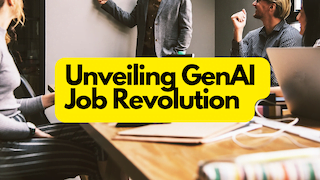The emergence of generative artificial intelligence (genAI) has generated both excitement and anxiety in today’s quickly changing technological landscape. Many predict that genAI will eventually replace many professions across multiple industries, mirroring previous concerns raised by the advent of groundbreaking technology.
The IT sector, however, sees genAI as a chance to create jobs rather than a danger to employment in spite of this uncertainty.
There is a lot of talk about how genAI will affect the workforce, but it’s important to think about the past. Similar to how the introduction of computers in the 1980s had typesetters anxious about becoming obsolete, the ensuing technological revolution actually resulted in the development of more jobs, including those for composers.
In a similar vein, new job opportunities, albeit distinct ones, will likely arise from the development of artificial intelligence.
The primary function of software, including genAI, is to improve productivity by automating tasks. AI-powered solutions may now effectively do mundane jobs like data entry and market research, freeing up human workers to concentrate on more significant and innovative projects.
The goal of this shift towards automation is to enhance human capabilities and free up workers to take on higher-value tasks rather than completely replace jobs.
Furthermore, genAI’s democratisation of content creation enables people of all skill levels to easily produce high-quality content. With the aid of genAI, users may now produce material that was previously limited to specialised knowledge, such as captivating photographs and written pieces.
Opportunities in the freelancing market are anticipated to grow as technology develops, providing gig economy workers with a multitude of new positions and projects.
The AI industry has a large potential for job growth despite worries about job displacement. Alongside the increased usage of genAI, new positions have evolved, like machine learning engineers, prompt engineers, and AI trainers. The workflows of sectors including sales, marketing, technology, and finance can also greatly profit from the use of AI technologies.
The capacity of genAI to lower expenses and improve operational efficiency is one of its main benefits.
AI models can anticipate problems and take proactive measures to address them, which reduces downtime and maximises resource utilisation. The need for qualified experts who can create and integrate AI solutions will only increase as more companies realise how valuable AI is for fostering creativity and productivity.
But adoption of AI is still moving at a modest pace, which will restrict its immediate influence on the labour market.
However, in order to maintain relevance and competitiveness in the rapidly changing digital landscape, companies who adopt AI technology early on are investing in training and upskilling their workers. While automation may present issues for low-skilled workers, human intervention is still vital, especially when it comes to quality assurance and decision-making processes.
Looking ahead, the symbiotic interaction between humans and AI will define the nature of work in the future.
Businesses have many chances for making progress as they make the shift to AI-driven operations.
People may set themselves up for success in an AI-enabled society where creativity, problem-solving, and strategic thinking are more important than ever by embracing lifelong learning and adjusting to new technology.
